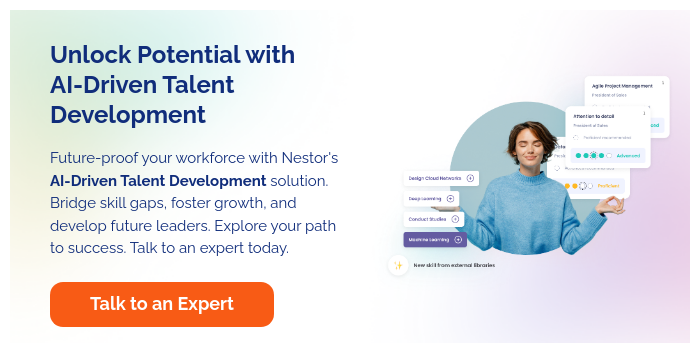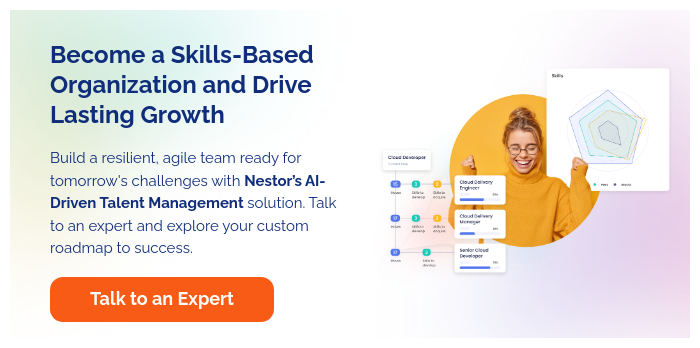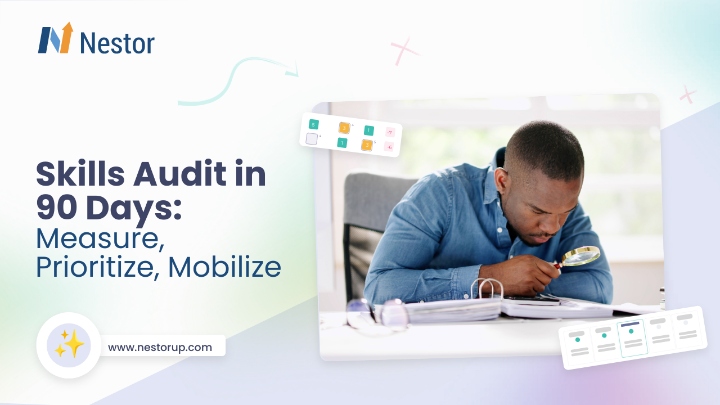
Contents
Every day, millions of professionals around the world wake up, get dressed, and head to work. They work on projects, attend meetings, and sit at their desks. However, how many of them actually recognize the range and depth of their own potential? How many can accurately pinpoint their strengths and weaknesses, or identify the skills they need to develop to stay competitive in their field? The art of skills self-assessment has become a potent instrument in this context, empowering people to take charge of their professional development and allowing organizations to better match their talent strategies with their overall company goals.
It’s no secret that the skills that were once considered essential just a few years ago are now rapidly becoming obsolete. In fact, a study by the World Economic Forum revealed that 50% of all employees will require significant reskilling or upskilling by 2025. That’s right, half of your workforce may need to acquire entirely new skills in the next five years to stay relevant and valuable. It’s a daunting statistic, to be sure, but it also highlights the urgent need for organizations to proactively address the skills gap and cultivate a workforce that is agile, adaptable, and ready to face the challenges of the future.
Intrigued? You should be. Because when implemented effectively, skills self-assessment can become a catalyst for unlocking unprecedented levels of performance, engagement, and growth within your organization. It’s a journey that promises to forever change the way you view and manage your workforce. So, get ready to embark on an exploration that will open your eyes to the true power of your people. From defining the right competency frameworks to leveraging cutting-edge technologies, we’ll dive deep into the keys to effective skills self-assessment – and uncover the common pitfalls to avoid along the way. By the end of this journey, you’ll be equipped with the insights and strategies needed to unleash the hidden gems within your workforce and position your organization for long-term, sustainable success.
What is Skills Self-Assessment?
At its core, skills self-assessment is a process of introspection and evaluation. It’s an opportunity for individuals to take a step back from their daily tasks and critically examine their professional abilities. This process involves identifying strengths, acknowledging weaknesses, and recognizing areas for improvement across a spectrum of both hard and soft skills. But skills self-assessment is more than just making a list of what you can and can’t do. It’s a nuanced exploration of one’s capabilities, experiences, and potential. When done effectively, it goes beyond surface-level competencies to uncover hidden talents, adjacent skills, and areas of untapped potential. It’s about understanding not just what you can do, but how well you can do it, and how your skills stack up against the evolving demands of your role and industry.
The Key Objectives of Skills Self-Assessment
The primary objectives of skills self-assessment can be boiled down to three key areas:
Identifying Current Competencies: By engaging in this process, employees gain a clear understanding of their existing skills, knowledge, and abilities. This self-awareness is the foundation upon which they can build their professional development plans.
Uncovering Skill Gaps: Skills self-assessment helps individuals identify areas for growth and improvement, enabling them to proactively address any gaps in their capabilities.
Guiding Career Progression: The insights gained through self-assessment empower employees to make informed decisions about their career paths, setting them up for long-term success and aligning their aspirations with the organization’s needs.
Comparing Skills Self-Assessment to Other Forms of Assessment
While skills self-assessment shares some similarities with other forms of evaluation, such as performance reviews or peer assessments, it stands apart in several key ways. Unlike performance reviews, which typically focus on past achievements and predefined metrics, skills self-assessment is forward-looking and more comprehensive in scope. It considers not just what an employee has done, but what they could potentially do given the right opportunities and development. Compared to peer evaluations, skills self-assessment offers a unique perspective – that of the individual themselves.
While external observations are valuable, they can’t capture the full picture of a person’s abilities, aspirations, and perceived limitations. Self-assessment taps into this insider knowledge, providing insights that might not be visible from the outside. However, it’s important to note that skills self-assessment isn’t meant to replace these other forms of evaluation. Rather, it complements them, offering an additional layer of insight that, when combined with external assessments, creates a more holistic view of an individual’s professional profile. The process of skills self-assessment can take many forms, from structured questionnaires and competency frameworks to more open-ended reflective exercises.
The Strategic Importance of Skills Self-Assessment
Its strategic importance lies not just in its ability to catalog existing skills, but in its power to shape the future of both individuals and organizations.
Aligning Skills with Business Goals
One of the primary strategic benefits of skills self-assessment is its role in aligning individual capabilities with organizational objectives. In many companies, there’s often a disconnect between the skills employees possess and the skills the organization needs to achieve its goals. This misalignment can lead to inefficiencies, missed opportunities, and frustration on both sides.
Skills self-assessment bridges this gap by providing a clear picture of the current skill landscape within the organization. It allows companies to identify where they have surpluses of certain skills and where there are critical shortages. Armed with this information, organizations can make more informed decisions about hiring, training, and resource allocation. For example, a technology company aiming to expand into artificial intelligence might discover through skills self-assessment that they already have several employees with relevant skills who are currently underutilized in their current roles. This insight could save the company significant time and resources in recruitment and allow for a faster pivot towards their new strategic direction.
Moreover, by encouraging employees to regularly assess their skills against the company’s needs, organizations foster a culture of proactive skill development. Employees become more attuned to the company’s direction and are more likely to independently pursue learning opportunities that align with organizational goals. This creates a workforce that’s not just reactive to change, but anticipatory and adaptive.
Empowering Employees
Perhaps one of the most strategically significant aspects of skills self-assessment is its role in empowering employees. Traditional top-down approaches to skill development and career planning can often leave employees feeling like passive recipients of training or victims of organizational change. Skills self-assessment flips this dynamic on its head, putting employees in the driver’s seat of their own development.
When employees are given the tools and encouragement to assess their own skills, they take ownership of their professional growth. This sense of ownership leads to increased engagement, job satisfaction, and loyalty. Employees who feel empowered to shape their own careers are more likely to stay with the company, reducing turnover and preserving institutional knowledge.
Moreover, empowered employees are more likely to seek out challenges and stretch assignments that push the boundaries of their current abilities. This proactive approach to skill development can lead to unexpected innovations and efficiencies as employees apply their growing skill sets to new problems and opportunities. From a strategic perspective, a workforce of empowered, self-aware employees who are actively managing their own skill development is an invaluable asset. Such a workforce is more resilient in the face of change, more innovative in approaching challenges, and more aligned with the organization’s strategic objectives.
Driving Continuous Improvement
The process of self-assessment often leads to increased self-awareness and metacognition – the ability to think about one’s own thinking and learning processes. This heightened awareness can lead to more efficient learning, better problem-solving, and increased creativity. Employees who are adept at self-assessment are better equipped to recognize when they need to acquire new skills or knowledge, and they’re more effective at doing so.
This culture of continuous improvement is essential in a world where the half-life of skills is rapidly diminishing. Imagine the consequences if your organization fails to keep pace with this rapid evolution – you could find yourself struggling to stay competitive, with a workforce that is ill-equipped to handle the challenges of the future. It’s not just about keeping up with the competition – it’s about staying one step ahead, positioning your company as an industry leader.
Implementing an Effective Skills Self-Assessment Process
Transforming the concept of skills self-assessment into a practical, effective process requires thoughtful planning and execution. It’s not enough to simply ask employees to list their skills; a truly impactful self-assessment process needs structure, support, and integration with broader organizational systems. Let’s break down the key steps to implementing a robust skills self-assessment process.
Step 1: Define Competencies and Skills
The foundation of any effective skills self-assessment process is a clear, well-defined competency framework. This framework serves as a common language for discussing skills across the organization and provides a structure for the assessment process. Creating a competency framework isn’t about making an exhaustive list of every possible skill. Instead, it’s about identifying the core competencies and skills that are critical to your organization’s success. This requires a deep understanding of your business strategy, industry trends, and the roles within your organization.
Start by engaging with leaders across different departments to understand the skills that drive success in their areas. What are the must-have technical skills? What soft skills set top performers apart? Are there emerging skills that will be crucial in the coming years? Next, look beyond your organization to industry trends and future projections. What skills are becoming increasingly important in your field? Are there new technologies or methodologies that are reshaping how work is done?
With this information, you can begin to construct a competency framework that reflects both your current needs and future aspirations. This framework should be comprehensive enough to cover the breadth of roles in your organization, but flexible enough to evolve as your needs change. Remember, the goal isn’t to create an intimidating laundry list of skills, but rather a clear, navigable map that employees can use to understand where they stand and where they might want to go. Consider organizing skills into broad categories (e.g., technical skills, leadership skills, interpersonal skills) and providing clear definitions and examples for each skill.
Step 2: Choose the Right Tools and Methods
With your competency framework in place, the next step is to select the tools and methods you’ll use for the actual assessment process. This is where technology can play a crucial role in making the process more efficient, engaging, and insightful.
One standout solution in this space is Nestor, a skills-based talent management platform that leverages AI to streamline the self-assessment process. Nestor offers a range of features that can significantly enhance your skills self-assessment efforts.
One of the key features of Nestor is its market library of over 20,000 skills, which is constantly enhanced by its AI-powered skills suggestions. This extensive skills database provides organizations with unparalleled visibility into their employees’ capabilities, enabling them to better understand the collective strengths and potential gaps within their workforce. Through Nestor’s intuitive interface, employees can easily navigate their own skills, assess their current proficiency levels, and identify areas for growth.
The platform’s AI-powered suggestions offer personalized recommendations for skill development, empowering employees to take an active role in their professional growth. By integrating Nestor into the skills self-assessment process, organizations can streamline the process and foster a supportive environment for their employees. Nestor’s talent growth and workforce planning features ensure that employees’ development aligns with the company’s strategic objectives, creating a win-win scenario for both the individual and the organization.
It’s like having a personal career coach for every member of your team – guiding them, nurturing their talents, and unlocking their full potential. With Nestor, organizations can transform their approach to skills management, ultimately driving greater employee engagement, retention, and overall business success.
But let’s not forget that, while platforms like Nestor can provide a powerful technological backbone for your self-assessment process, it’s important to remember that technology is a tool, not a solution in itself. The effectiveness of your self-assessment process will depend on how well you integrate these tools with your broader talent management strategy and organizational culture.
Step 3: Facilitate a Supportive Environment
For skills self-assessment to be truly effective, it needs to take place in an environment where employees feel safe to be honest about their strengths and weaknesses. This is perhaps one of the most challenging aspects of implementing a self-assessment process, as it requires a shift in organizational culture. Start by clearly communicating the purpose of the self-assessment process. Emphasize that it’s not about judgment or performance evaluation, but about personal growth and organizational development. Be transparent about how the information will be used and who will have access to it.
Leadership plays a crucial role in creating this supportive environment. Encourage leaders to model the behavior by openly discussing their own skill development journeys. When leaders are vulnerable about their own areas for improvement, it sends a powerful message that it’s okay to acknowledge weaknesses. Consider implementing a coaching or mentoring program alongside your self-assessment process. This can provide employees with support and guidance as they navigate their skill development journey. Coaches or mentors can help employees interpret their self-assessment results, set development goals, and create action plans.
It’s also important to recognize and celebrate skill development efforts. This doesn’t mean only praising those who have mastered new skills, but also acknowledging the effort and courage it takes to identify areas for improvement and work on them. Create opportunities for employees to share their learning experiences, whether through internal newsletters, team meetings, or dedicated learning events.
Step 4: Integrate with Broader HR Processes
For skills self-assessment to have a real impact, it needs to be integrated with other HR processes and organizational systems. This integration ensures that the insights gained from self-assessment translate into tangible actions and outcomes. One key area of integration is with learning and development programs. Use the data from self-assessments to inform the design and delivery of training programs. Are there common skill gaps across the organization that could be addressed through targeted workshops or courses? Can you create personalized learning paths based on individual assessment results?
Career planning is another crucial area for integration. Use self-assessment data to help employees map out potential career paths within the organization. This could involve creating skills-based job profiles that show employees what skills they need to develop to move into different roles. Succession planning can also benefit from skills self-assessment data. By having a clear picture of the skills present in your organization, you can more effectively identify and develop potential future leaders.
Performance management is yet another area where self-assessment can play a role. While it’s important to keep self-assessment separate from performance evaluation, the insights gained from self-assessment can inform goal-setting discussions and development plans. Finally, consider how skills self-assessment data can inform strategic workforce planning. By understanding the current skill landscape in your organization and how it’s evolving over time, you can make more informed decisions about hiring, reskilling, and organizational design.
Implementing an effective skills self-assessment process is no small task. It requires careful planning, the right tools, a supportive culture, and integration with broader organizational systems. However, when done well, it can transform how your organization understands and develops its most valuable asset – its people.
As we move forward, we’ll explore some common pitfalls in implementing skills self-assessment and how to avoid them, ensuring that your efforts yield the best possible results.
Common Pitfalls on Skills Self-Assessment and How to Avoid Them
Even with the best intentions and careful planning, implementing a skills self-assessment process can come with challenges. Being aware of these potential pitfalls and knowing how to navigate them can make the difference between a transformative initiative and a frustrating exercise. Let’s explore some common challenges and strategies to overcome them.
Bias and Overconfidence
One of the most significant challenges in skills self-assessment is the potential for bias. Humans are notoriously bad at objectively evaluating their own abilities. This can manifest in various ways:
The Dunning-Kruger effect: people with limited knowledge in a domain overestimate their competence.
Imposter syndrome: highly skilled individuals underestimate their abilities.
Self-serving bias: people attribute successes to their skills but failures to external factors.
These biases can lead to inaccurate assessments, potentially undermining the entire process. While self-assessment is valuable, it shouldn’t stand alone. Combine it with peer feedback, manager evaluations, and objective performance data to create a more balanced view. When asking employees to assess their skills, give them specific, observable behaviors or outcomes to consider. Instead of asking “How good are you at project management?”, ask “How often do you deliver projects on time and within budget?”
Educate employees about common biases and provide strategies for more objective self-evaluation. This could include techniques like keeping a work diary to track accomplishments and challenges or using specific examples to support skill ratings. Before the formal assessment, have employees practice assessing a fictional person’s skills based on a detailed description. This can help them understand what different skill levels look like and improve the accuracy of their self-assessments.
Additionally, your organization can leverage data-driven technologies, such as those offered by Nestor, to provide employees with personalized feedback and skills insights. By combining self-assessment with skills management tools, the risk of bias and overconfidence can be significantly reduced, empowering your people to make more informed and accurate assessments of their capabilities.
Infrequent Assessments
Another common pitfall is treating skills self-assessment as a one-off event or an annual checkbox exercise. This approach fails to capture the dynamic nature of skill development and can lead to outdated or irrelevant data. To avoid this make sure it’s an ongoing process. Instead of annual assessments, consider implementing a continuous feedback model where employees can update their skill profiles regularly. Encourage employees to reassess relevant skills after completing major projects, attending training sessions, or taking on new responsibilities.
Lack of Follow-Through
Even with a robust skills self-assessment process in place, the true impact of the initiative can be undermined by a lack of follow-through. If the insights gained from the assessments do not translate into meaningful action, the entire exercise can become little more than a time-consuming bureaucratic exercise. To avoid this pitfall, organizations must ensure that the skills self-assessment process is closely integrated with the organization’s broader talent management strategies. This includes the creation of personalized development plans, the allocation of targeted training resources, and the implementation of career progression pathways that align with the identified skills and competencies.
The Future of Skills Self-Assessment
The world of business is dynamic and changing very fast, and to keep pace with this trend, skills self-assessment will also need to evolve significantly in the coming years. This transformation will be driven by several key factors, including the rapid advancement of new technologies and the emergence of new insights enabled by the analysis of vast amounts of data.
Technological Advancements
The emergence of artificial intelligence (AI) and machine learning (ML) is about to transform the way organizations look at skills self-assessment. These tools have the ability to give employees a lot of individualized and detailed information, based on a huge collection of data, on what they are good at and what they need to develop.
For example, Nestor’s AI-powered skills mapping capabilities can help with the creation of a dynamic skills inventory, Nestor can provide organizations with unprecedented visibility into their workforce’s capabilities, enabling them to make more informed and strategic talent decisions.
Personalization and Predictive Analytics
As the skills self-assessment process becomes more data-driven, organizations will increasingly utilize predictive analytics to create tailored development plans and career progression pathways for their employees. By combining individual self-assessment data with organizational goals and workforce projections, these analytics-driven systems can identify the optimal learning and growth opportunities for each employee, ensuring that their skills remain relevant and valuable to the company.
Nestor’s Talent and Opportunity Marketplace, for instance, leverages AI-powered smart-matching to connect employees with the most relevant gigs, projects, and open roles based on their skills and competencies. This personalized approach not only empowers employees to take charge of their career development but also helps organizations to strategically deploy their talent, ensuring that the right people are in the right roles at the right time.
Adaptive Learning
Building on the personalization and predictive capabilities of skills self-assessment, the future will see the rise of adaptive learning systems that can dynamically adjust training and development content based on individual needs and performance.
These adaptive learning platforms will use self-assessment data to create personalized learning journeys, continuously adjusting the pace, delivery, and content of the training to ensure maximum engagement and skill retention. By seamlessly integrating the self-assessment process with ongoing learning and development, organizations can foster a culture of continuous improvement and lifelong learning – a critical advantage in the face of rapidly evolving skills demands.
Final Thoughts
The importance of skills self-assessment for companies cannot be underrated in the dynamic environment of the modern business world. Employees’ active participation in shaping their own career paths and matching their skills to organizational goals can drive untold heights of performance, innovation, and growth through this process.
As we have explored in this article, the implementation of an effective skills self-assessment process requires a multifaceted approach, from developing a solid competency framework and identifying the right tools and technologies to integrating the process with other HR initiatives.
By addressing common pitfalls and embracing the transformative potential of emerging technologies, organizations can position themselves at the forefront of the skills-based talent management revolution. Through this strategic investment in their workforce, companies can cultivate a future-ready talent pool that is agile, adaptable, and primed to navigate the challenges and opportunities of the years to come. The time to act is now.












